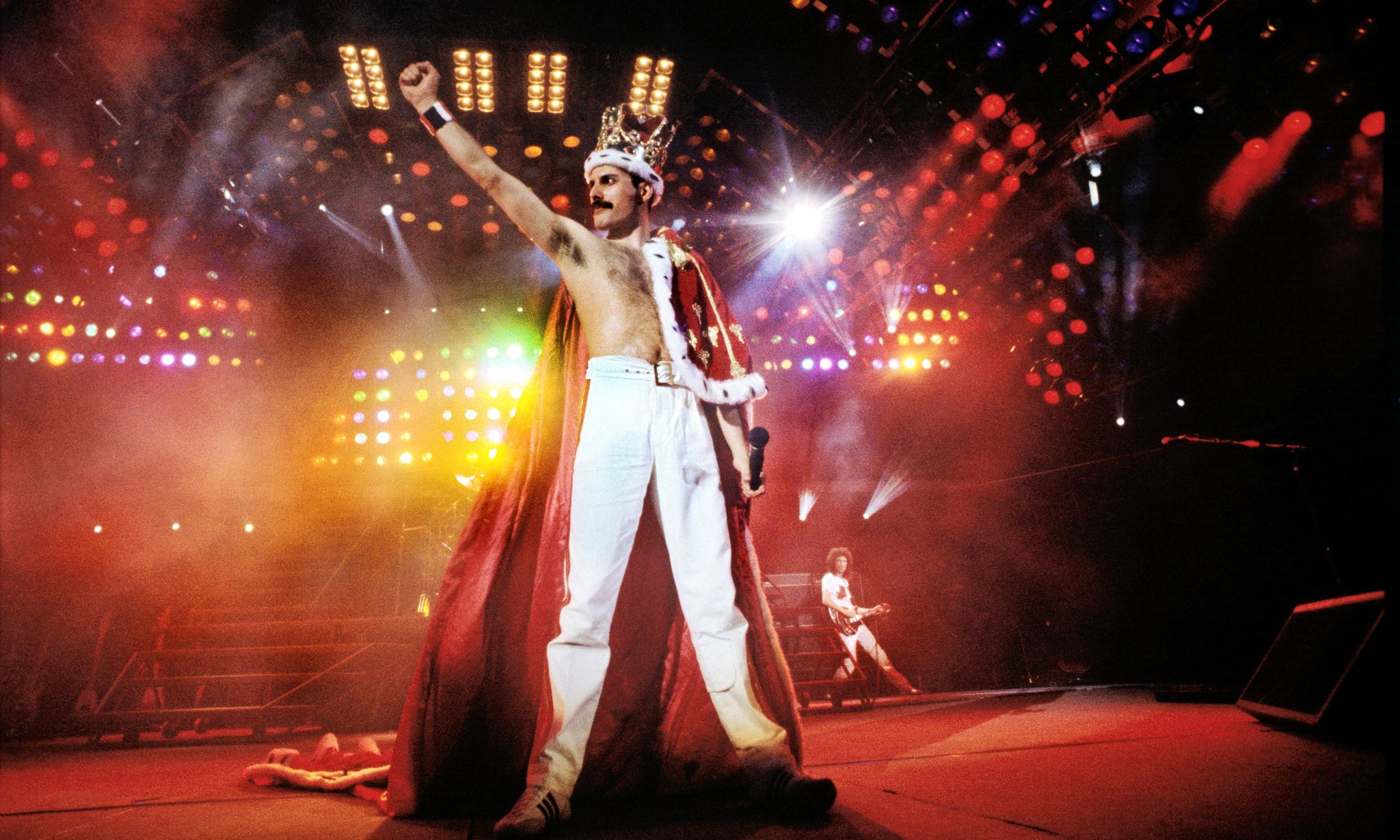Freddie Mercury performing with Queen at Wembley Stadium, London, during the Magic Tour, July 1986
Photo: Denis O'Regan/Getty Images
It had, without a doubt, been coming. Following one of the most hype-filled buildups to an auction in recent history, the evening sale of Freddie Mercury’s personal treasures at Sotheby’s London last night lived up—on the most part—to the sense of drama and surprise synonymous with the man himself. Cruising beyond its pre-sale estimate of £4.8m-£7.2m to total £12.2m, the white-glove auction was a testament to both the enduring allure of the Queen frontman and the power of personality in today’s art market.
The 59 lots on offer represented the crème de la crème of the collection drawn from Mercury’s Kensington home, Garden Lodge, which he had bequeathed to his lifelong friend Mary Austin. In the run up to yesterday's sale, it had all been on view in an exhibition at Sotheby’s that drew in an astounding 140,000 visitors in just one month, with queues snaking around the block for much of that time. Wednesday’s evening sale alone—part of a series of live and online auctions that will conclude on 13 September—had attracted 2,000 registrations, a record at Sotheby’s and likely beyond.
The evening, fittingly then, began with a clamour just to get through the gates, as bidders fought it out for 25 minutes for the garden door from the Kensington house. The object, covered from top to bottom in fan tributes, sold to a phone bidder for £350,000 (£412,750 after fees), far exceeding its £25,000 high estimate.
The Garden Lodge door
Courtesy Sotheby's
Several impressive results followed, including a Tiffany “Lily” table lamp that reflected Mercury’s love for Art Nouveau, and which sold for £48,000 (£60,960 after fees) against a high estimate of £12,000. A Fabergé vesta case, which reportedly resided in Mercury’s bedroom, performed even more impressively—going for £75,000 (£95,250 after fees) to an online bidder.
Notably, given the venue, it was fine art that brought an early lull. Italian artist Eugene von Blaas’s portrait of a woman theatrically posing with a rose only mustered £55,000 (£69,850 after fees) against a low estimate of £70,000, while a tender picture by James-Jacques-Joseph Tissot of his lover Kathleen Newton—the last work of art Mercury bought—came in below its £400,000 low estimate to sell to an online bidder for £380,000 (£482,600 after fees).
Auctioneer Oliver Barker, for his part, remained in a jovial mood throughout—“we’ll have to do a Freddie refrain while we wait,” he said after a specialist lost connection to their bidder—and this was matched by buoyant reactions from the crowd when things inevitably picked up. A contender for Joan Miro’s print Le Matador (Dupin 510) drew laughs as she asked if she could take a closer look at it from her seat, while loud applause echoed around the room as a collector on the floor acquired a Showa period screen—one of several objects conveying Mercury’s penchant for Japanese culture—for £150,000 (£190,500) against a £12,000 high estimate.
Utagawa Hiroshige, Sudden Shower over Shin-Ohashi Bridge and Atake | (Ohashi Atake no yudachi), Edo period, 19th century
Courtesy Sotheby's
A striking woodblock print by Utagawa Hiroshige stole the show from an art historical standpoint. Sudden Shower over Shin-Ohashi Bridge and Atake (Edo period, 19th century) depicts rain lashing down on pedestrians crossing a bridge. It was a work highly coveted by Mercury and a fine example of Hiroshige’s output, which would inspire Vincent van Gogh among others. It sold for £230,000 (£292,100 after fees) against a high estimate of £50,000.
It is perhaps unsurprising, however, that the most thrilling battles were saved for those objects that Mercury would have touched, grasped and danced in. There were gasps of excitement when his silver snake bangle, worn in the music video for hit ballad Bohemian Rhapsody, soared past its high estimate of £9,000 to sell for £550,000 (£698,500 after fees). Barker was on form again as a series of outfits worn by Mercury came up for their turn. “It’s like a Friday night in Blackpool,” he remarked as bidding went wild for a wrap-around top and satin trousers worn by the frontman for the cover shoot of Queen’s second album, Queen II (it sold for £40,000, or £50,800 after fees).
The atmosphere among specialists and public alike was buoyant throughout the evening
Courtesy Sotheby's
It was indeed an unusually carnivalesque atmosphere for Sotheby’s, and the biggest cheers of the night were saved for draft lyrics to hit Bohemian Rhapsody, which surpassed the six figure mark to sell for £1.1m (£1.3m after fees, against a £1.2m high estimate). Earlier, a Wurlitzer jukebox, bought for Mercury’s kitchen, achieved more than 20 times its low estimate when it was acquired by a bidder in the room for £320,000 (£406,400 after fees).
Mercury’s baby grand Yamaha piano—on which he wrote world-famous songs including Don’t Stop Me Now, Somebody to Love and Rhapsody—was the highest-achieving lot, selling for £1.4million (£1.7m after fees), albeit against a £2m low estimate. But the crowning moment of the evening was, arguably, the arrival of the crown and cloak that Mercury had worn on Queen’s Magic tour in 1986. The crowd was raucous as the plush, velvety ensemble–with its imitation ermine, gold and jewels– sold for £500,000 (£635,000 after fees) to a buyer in the room.
Mercury's baby grand Yamaha piano
Courtesy Sotheby's
There was still time for the remaining lots to send the auction out on a high—a particularly worn-looking pair of Adidas trainers selling online for £100,000 (£127,000 after fees), against a £5,000 low estimate, and intimate photographs of Mercury achieving a similar sum.
Proceedings ended with a rendition of “We Will Rock You”, specialists banging their hands against their desks. A victory for Sotheby’s, perhaps, and for a good number of Freddie Mercury’s most affluent fans. For the rest of us, a reminder of the pull of an icon, and a prompt to consider where such auction house spectacles might be going next.

